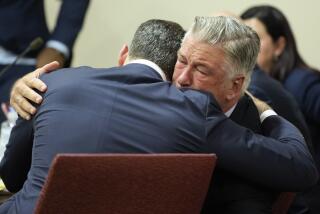Muhammad Sniper Case Goes to the Jury
- Share via
VIRGINIA BEACH, Va. — The serial murder trial of John Allen Muhammad went to a jury Thursday as Virginia prosecutors recounted the sniper suspect’s alleged onslaught of “death and destruction” across the East Coast and urged a guilty verdict that could lead to his execution.
Virginia Beach jurors began deliberations late Thursday afternoon after a defense lawyer for Muhammad insisted there was no direct evidence of his guilt and tried to seed doubts within the state’s massive collection of physical evidence.
Prince William County Circuit Court Judge LeRoy F. Millette Jr. adjourned the panel of seven women and five men after 15 minutes and told them to return today.
As the sniper trial drew to a close after five weeks of testimony from 140 witnesses, Muhammad masked his wooden countenance behind cupped hands, his familiar posture for much of the proceedings. Immobile in a dark brown suit, Muhammad watched stonily as Prince William County Commonwealth Atty. Paul B. Ebert glared at him during a final statement urging his conviction.
“He was able to kill,” Ebert said, “because of the evil that hides within him.” The prosecutor depicted Muhammad as the “No. 1 perpetrator” of last year’s sniper shootings that put Washington, D.C.-area residents under a “reign of terror.” In all, Muhammad has been linked to 10 slayings and six shootings.
Charged with the Oct. 9, 2002, slaying of Maryland civil engineer Dean Harold Meyers, Muhammad, 42, faces two counts that could bring a death sentence -- one for committing multiple slayings over three years and a second for killing Meyers during an act of terrorism. Muhammad’s co-defendant, Jamaican immigrant Lee Boyd Malvo, 18, is on trial for another of the killings in a nearby Chesapeake courtroom.
Acknowledging the “horrible things” wreaked by the sniper rampage, Muhammad’s defense lawyer, Peter D. Greenspun, faulted prosecutors for their lack of eyewitnesses and direct evidence in any of the killings.
“Suspicion and probable guilt are not enough for conviction,” Greenspun said in a two-hour summation that probed for flaws in a government case that has seemed impregnable since Muhammad and Malvo were arrested 11 months ago.
Over the last five weeks, three northern Virginia prosecutors have built a formidable circumstantial case against Muhammad, relying heavily on an assault rifle and “snipercraft” instruments seized from his car -- from maps and walkie-talkies to a stolen laptop. Prosecutors repeatedly introduced ballistics and forensics matches between the gun and crime scene traces and nudged graphic testimony from police, shooting survivors and relatives of the dead.
“This is a very compelling display of evidence,” assistant prosecutor Richard A. Conway said in remarks earlier in the day. Conway motioned to a white cardboard courtroom display showing the faces of victims and listing the evidence in each of their cases. “Fifteen crime scenes. You have ballistics. You have DNA evidence. You have fingerprints. Uncontradicted.”
Greenspun, a combative courtroom tactician who had given prosecutors little quarter, admitted the heft of the government’s evidence. Muhammad’s defense lawyers “are here with a daunting task,” he said.
But Greenspun soon returned to a more pugnacious mode, questioning the prosecution’s depiction of Muhammad as the moving force in the killings. Even conceding that jurors might convict Muhammad of murder, Greenspun insisted they could not find him guilty of a death penalty-eligible crime because prosecutors had failed to show that Muhammad had fired the rifle or intended the crimes as an act of terrorism.
Prosecutors had suggested that Muhammad may have fired some of the fatal shots, but admitted that most were fired by Malvo. In the end, Ebert said, it made no difference. A 1991 Persian Gulf War veteran who was an able marksman, Muhammad planned the killings, Ebert said, and obtained the Bushmaster .223-caliber assault rifle. And he maintained a soldier-like sway over the younger Malvo, he said.
“This man had a record in the military of being able to train people and use people,” Ebert said. “He had recruits under his command.” Conceding that Muhammad “needed assistance,” Ebert said the men acted “as joint participants in this crime.”
“There’s no indication Mr. Muhammad trained Mr. Malvo for anything,” Greenspun countered. Prosecution witnesses from Washington state said Muhammad, who made that area his home base in recent years, testified that Muhammad took Malvo out almost every day for target practice in late 2001. But their accounts did not detail how Muhammad maintained a strict hold over the younger man.
“The commonwealth has no evidence of any direction or control or indoctrination,” Greenspun said. “They’re trying to say he was obedient and, therefore, Mr. Muhammad made him do it. But he was obedient without any demonstration of where this came from.”
But the two Virginia prosecutors repeatedly returned to their contention that Muhammad and Malvo operated as an “inseparable” unit, adopting the clandestine tactics and techniques of military snipers.
Referring to trial testimony by a British sniper expert, Ebert said Muhammad modified the trunk of his Chevrolet Caprice with a sawed-out hole through which to fire the murder weapon. He and Malvo moved about the Washington, D.C., area as if it were enemy territory, using maps to sketch out routes and rehearsing ransom notes on a stolen Sony laptop, he said. They even slipped into military lingo, referring to enemy “forces” in one of their notes demanding $10 million, Ebert noted caustically.
“It took two people,” he said. “Use your common sense. Anyone who would get in that car and shoot out of that opening would have to have someone else to help.”
More to Read
Sign up for Essential California
The most important California stories and recommendations in your inbox every morning.
You may occasionally receive promotional content from the Los Angeles Times.













